Do I Have an Ice Dam Problem?
Tuesday, March 29th, 2016
Roof Leaks Caused by Ice Dams on Roof and in Gutters
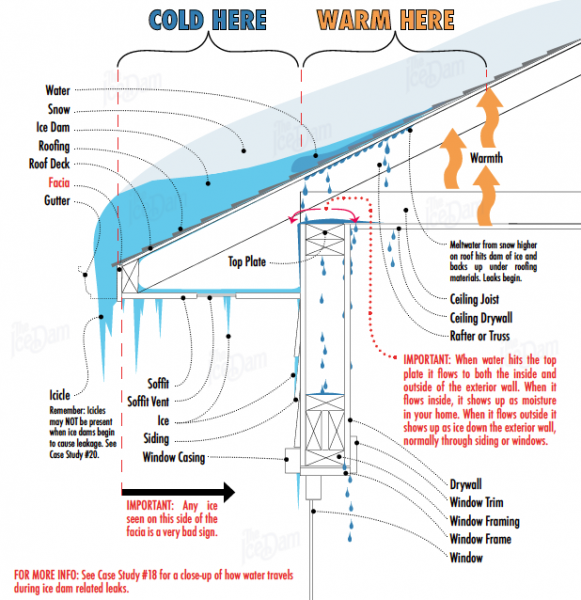
Tuesday, March 29th, 2016
Roof Leaks Caused by Ice Dams on Roof and in Gutters

Tuesday, September 29th, 2015
I was recently interviewed by Realtor Magazine for a piece about preparing home buyers for severe weather –including Ice Dams, why ice dams happen and ice dam prevention methods.
You can read the full Article at Realtor Magazine Here:
Help Clients Prepare for Weather Challenges
The piece also discusses other weather related problems and disasters that can happen from strong winter weather. Check it out. I am frequently interviewed from media and professional sources from all around the country on the topic of ice dams because I started The Ice Dam Company so long ago. We are in fact the largest and the oldest ice dam prevention and ice dam removal company in the country. Before the Ice Dam Company, no other company existed that specialized in this area of business. Now, of course, the web is littered with ‘experts’ and ‘specialists’ purporting to be leaders.
-Steve Kuhl
Sunday, December 22nd, 2013
We directly handle over 100 insurance claims each year through our sister company, Kuhl Design+Build, including claims that relate to damage done by ice dams in the Minneapolis area. By ‘we’ I mean to say Pete Denboer, our in-house insurance specialist. Pete was an adjuster for over twenty years before he joined our company and trust me when I say we have all learned a great deal from him about the tricks insurance companies play to avoid coverage. But I digress…
I frequently get asked a few questions relating to ice dams and home owners insurance. Here are some of the more common questions and answers:
Question: Does homeowners insurance cover ice dam removal? Answer: Sometimes Yes, sometimes No. Okay, on rare occasion an insurance company will cover preventative ice dam removal but it is very unusual. This applies to ice dams that are not causing a roof leak. Typically that sort of
service is provided only by the high-end insurance companies like Chubb, Ace, Amica, AIG and Fireman’s Fund. Insurance companies do frequently cover the cost of removing ice dams that are causing damage (i.e., leaking). If you have questions about this distinction you can call your insurance agent. Be careful about how you characterize your ice dam situation, however. If you claim that only one part of your home is leaking that is the only part of the ice dam removal cost they will cover. An adjacent ice dam that you thought might not be the source could very well be the one that was causing the leak and your insurance company may hesitate to pay for the removal.
Question: Does insurance cover the damage done by ice dams? Answer: Yes. The caveat being that some insurance companies cover more than others. Ultimately, if you are working with a guy like Pete just about any insurance company will listen to reason. We often get called in after an ice dam insurance claim has been initiated by the homeowner who, not knowing any better, believes in the assessment made by the adjuster. I remind clients to remember who signs the adjuster’s paycheck. They have extensive training in minimizing loss severity while wrapping it in a facade of good customer service. Pete cuts through all of that pretty quickly and determines the scope of the damage and what it will take to fix it.
Question: Should I file a claim for my ice dam? Answer: It depends. Your deductible will be the primary variable in determining whether your should file an insurance claim for an ice dam. The lower the deductible, the more reasonable the idea of filing becomes. Of course the other key consideration is the extent of the damage. If the damage done by the ice dam is only $500 and your deductible is $400, it’s probably not worth the hassle. Having us provide an estimate for the cost of repairs is a good way of answering the question of whether or not to file.
Question: Will insurance pay for a new roof due to an ice dam? Answer: No. In fact, ice dams and the damage they cause are not a roof issue. You read that right. Ice dams are not an indication that a roof has problems. They are first and foremost an indication that heat is doing naughty things. Specifically, heat is warming the roof system enough to cause the snow to melt, run to the cold edge and refreeze.
Question: How to file an insurance claim relating to ice dams? Answer: Filing an insurance claim to help repair the damage done by ice dams is no different that any other home owners claim. Your first call should be to us to remove the ice dam. Your next call should be to your insurance company to file a claim. From there you will be assigned an adjuster who will visit your home shortly, usually within a few days. The adjuster will generate a quick estimate of the damages and costs and issue a check almost immediately to you. Most large insurance companies such as State Farm, Travelers, Farmers, Allstate and American Family use a common technique to simultaneously depress the size of claims while maintaining homeowner happiness. They get the adjuster out to your home very quickly and then write you a check for the damages immediately. Not knowing what the true extent of the cost of repairs is, you will most likely be impressed even though they have likely missed much of the hidden damage created by the ice dam and subsequent water intrusion into your home. I’ve seen this approach used hundreds of times. It’s a classic.
Question: What are common forms of damage done by ice dams to Minneapolis homes? Answer: The most common damage done by ice dams relates to the effects of water inside walls, ceilings and floors. Water will cause permanent buckling of hardwood floors. It will permanently damage insulation by diminishing its’ R-Value by as much as 50%. It will cause mold inside wall cavities. It can collapse ceilings. Really, I’ve seen just about everything. Our thermal imager is a favorite method used to find water where it otherwise is hidden.
Thursday, January 31st, 2013
This past week, we were called out to a Fairview Hospital to resolve an ongoing roof leak in their EPDM roof or rubber roof. The roof leak, they suspected, was being caused by an massive ice build up on their flat roof. The area covered in ice was approximately 1200 square feet and ranged between 3-5″ thick. They had gotten another bid from acompetitor to remove the entire ice field for around $8,000.
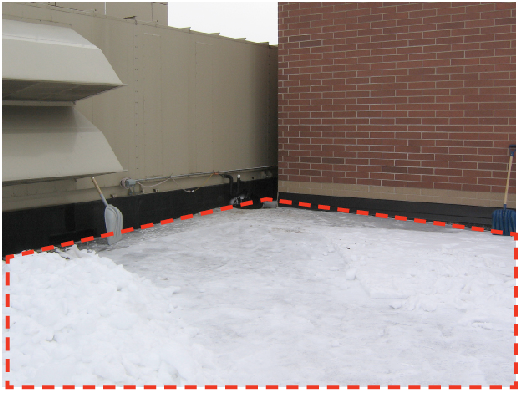
Upon visiting the site, we quickly determined it was not necessary to remove the entire ice field in the area. Our experience as professional roofers and our use of thermal imaging quickly pointed us to a bad corner flashing detail as shown here. This area was completely covered by ice and was the main source of their leak.
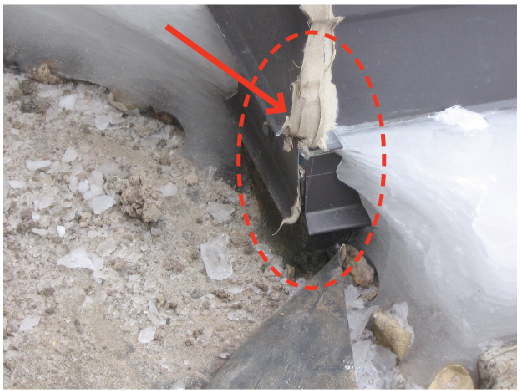
The job was quite simple. We used our commercial steamers to cut through the ice and clear a channel from the area around the leak to the nearest roof drain. This allowed any melted snow/ice to run directly to the drain, instead of being dammed up and leaking into the hospital.
We also removed a the large section of ice that surrounded the leak area to allow for proper repair of the roofing and flashing that had failed. Fairview was so happy with our work that they ended up having us remove rest of the ice in that surrounding area. In the end, our cost for all of the work was half that of our competitor’s estimate. We pride ourselves in doing business under the philosophy that we’re trying to build lasting, honest relationships. Not just trying to earn the quick buck. Our guess is that we will be called for all ice removal needs by the Fairview Hospital network going forward. A lot of ice removal companies in the Minneapolis area are allergic to honesty. Perhaps Fairview has an ointment for that?
Thursday, January 3rd, 2013
An article in popular mechanics recently published about Ice Dam Prevention, and What to do if you have ice dam problems gets the basics:
To prevent an ice dam, don’t heat the roof, keep it cold. That way, the snow on the roof eventually dissipates without making large amounts of meltwater. The underside of the roof deck should not exceed 30 F. The best way to maintain low temperatures is by ensuring that there is adequate insulation and sealing gaps that let warm air pass into the attic from the house. The attic must also be ventilated, so that cold air is introduced into it and heated air escapes rapidly. Some remodeling contractors are under the impression that heat passing through the attic helps prevent ice dams, when just the opposite is true. Although excess heat moving from the attic through the roof rapidly melts snow, once the meltwater touches the cold eaves, it quickly freezes and forms an ice dam.
Read the full Popular Mechanics Ice Dam Article Here
…Then the article falls short at really looking at solutions to identify root problems (other then proper insulation) and determining solutions. Instead it looks at situations where there’s a furnace in the attic, and then turns it’s focus to cosmetically hiding symptoms of ice dams. Before you go this route, you really should determine what the underlying problem is, and fix it.
If you don’t feel confident in attempting to diagnose and fix ice dam problems yourself, it’s always a good idea to contact a contractor that has a Minnesota State Certified Energy Auditor on staff, has experience in insulation & ventilation installs, fixing roof leaks and making stuff look good.
Tuesday, December 18th, 2012
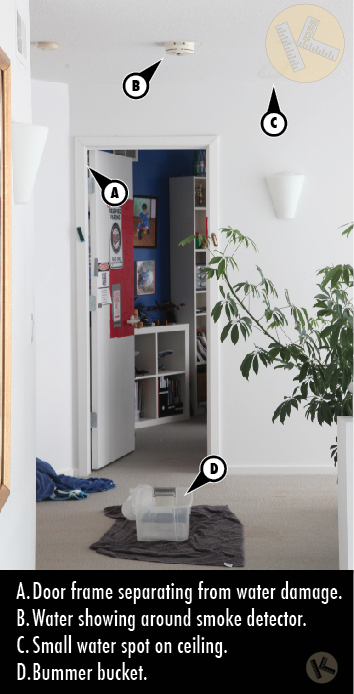
Here is what a leak from an ice dam looks like.
Ice dams cause leaks in Minneapolis homes but not usually until later in the ice dam season. I received a call earlier today from a client in Edina with water pouring through her ceiling. The water was coming through a smoke detector (B) and soaking her floor. One interesting but not entirely surprising thing was that the water affected a much larger area than was obvious from below (also showed at location C). Slight cracking in the door frame also indicated water problems (B).
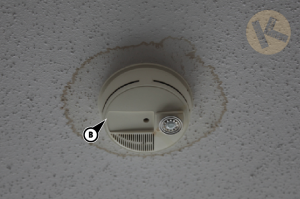
When I looked up I notice a ring of discoloration around the smoke detector (seen in photo, above). The thermal imager revealed a 6′ x 6′ area of wetness around the smoke detector. The client had a hard time understanding why the water had not shown in a larger area until I explained how her ceiling assembly worked. Because there was unconditioned space above the drywall there was also a code required vapor barrier, i.e, plastic sandwiched between the drywall and the ceiling framing. When the ice dam above caused water to back up and leak into the home it collected on top of the ceiling until it found the path of least resistance in the vapor barrier. In this case that was a smoke detector but it is often a light fixture, a vent or a seam in the plastic itself.
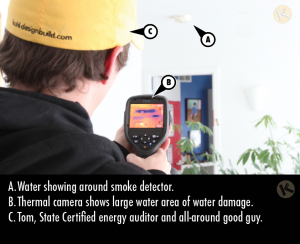
Ice dam removal in Edina
A quick look at the thermal image shows a large dark purple area (photo left, point B). This is wetness that has not yet manifested visually from below. It is damage nonetheless and should be repaired.
We take immense pride in being industry leaders in ice dam prevention, insulation and ice dam removal. There isn’t another ice dam removal company in town that has thermal imaging technology in-house or guys like Tom, who are certified geeks in all things relating to home performance technology.
The Ice Dam company based out of Hopkins, Minnesota, about 5 miles west of Minneapolis. We've done gutter ice removal, roof ice removal and ice dam removal all over the Twin Cities, on new houses and old ones.
Some of the more frequent places we've done ice dam services are:
Copyright © 2024, The Ice Dam Company. All rights reserved.